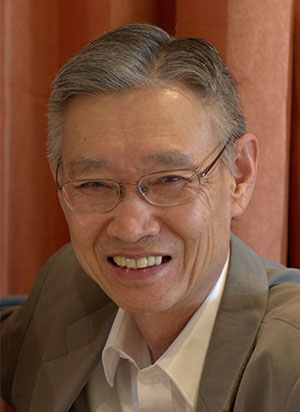 What’s your Einstein number? For retired faculty member and chair of the Southern Illinois University Edwardsville Department of Mathematics and Statistics Chung Wu Ho, PhD, it’s four. That means only three collaborators separate him from Albert Einstein, according to the American Mathematical Society (AMS).
What’s your Einstein number? For retired faculty member and chair of the Southern Illinois University Edwardsville Department of Mathematics and Statistics Chung Wu Ho, PhD, it’s four. That means only three collaborators separate him from Albert Einstein, according to the American Mathematical Society (AMS).
The AMS has developed a tool that shows the collaboration distance between two researchers, including famous mathematicians such as Einstein. Researchers who have collaborated directly with Einstein have an Einstein number of one; anyone who has collaborated with that researcher then has an Einstein number of two, and so on. This tool led Ho to discover his connection to Einstein was closer than expected.
“I was a little surprised to find that I was connected to Albert Einstein by such a short chain of collaborators,” said Ho, an SIUE professor emeritus. “But Einstein was very active, collaborating extensively with mathematicians. Collaboration is common in scientific research.”
Ho may be humble in his surprise, but based on the 30 research papers he has published during his career, his Einstein number is no surprise to others. Ho continues adding to his list of published work. In fact, two of his most recent papers – in addition to a third that will appear later this year – were published after his 80th birthday.
“My last two papers studied the structure of the real number system. A third one, which will appear this year, is also on the property of numbers,” explained Ho.
Ho’s long history of research is combined with his lengthy career in academia. He began teaching in the SIUE Department of Mathematics and Statistics in 1970, served as department chair from 1988-1994 and retired in 2000. During his career, Ho was a three-time recipient of SIUE’s Teaching Excellence Award and a nominee for the 1999 U.S. Professor of the Year Award sponsored by the Council for Advancement and Support of Education and the Carnegie Foundation for the Advancement of Teaching.
When Ho thinks back on his time at SIUE, “the most important parts of my memory at SIUE are the students, faculty and the beautiful campus, in that order.” Working in reverse, he notes how the peaceful rolling hills on campus and lasting friendships he developed with his colleagues made his time at SIUE enjoyable. But the memories Ho created while teaching and collaborating with students are his fondest.
He recalls the 12-year-old student who successfully completed a double degree program in mathematics and physics before going on to earn his doctorate and launch a successful career at Cisco Systems. Another former student founded a software company that developed a program widely used by researchers for finding a cure for Alzheimer’s disease.
“In 30 years, I taught many students, some of whom have become my lifelong friends,” said Ho. “By the year of my retirement, most high schools in the bi-state area had at least one math teacher who was my student at one time.”
Ho’s fondness for his students was mutual. He remembers a student who told him he was a topic around the dinner table at her house because her mother had also been a student of his.
“Another time my wife and I were treating some friends in a restaurant in St. Louis,” Ho recalls. “The waiter kept bringing to our table some fancy dishes we did not order. I asked him whether there was any mistake. The restaurant owner stepped out. He was one of my old students, telling me that all the dishes were provided with his compliments. All of these are part of my fond memories.”
After retiring from SIUE in 2000, Ho moved to California and continued teaching mathematics at Evergreen Valley College for the next 16 years. Even after his second retirement, he remains a part-time faculty member at the school and an avid researcher. When asked what motivates him to continue his research, the octogenarian replied, “My answer is: old habits die hard.”
Photo: SIUE Department of Mathematics and Statistics Professor Emeritus Chung Wu Ho, PhD.